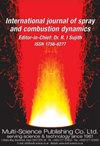用高速成像技术表征含硼浆料燃料的喷雾特性
IF 2.1
4区 工程技术
Q3 ENGINEERING, MECHANICAL
International Journal of Spray and Combustion Dynamics
Pub Date : 2023-02-01
DOI:10.1177/17568277231151909
引用次数: 1
摘要
雾化喷雾的结构、破裂和液滴形态是分析发动机性能的关键。因此,本研究通过高速成像技术对含硼浆状燃料的喷雾特性进行了实验评价。测定了含硼浆液燃料的流变性能,定性分析了其对雾化行为的影响。通过对时间序列图像的处理,得到了喷雾锥角、穿透长度、破片长度、韧带长度、韧带直径和液滴直径分布。实验在三种雾化气液比(ALR)下进行。分析了不同颗粒载量(10%、20%和30%)的燃油样品的喷雾特性,并与纯Jet A-1进行了比较。采用动量通量比、韦伯数、奥亨索格数、雷诺数等不同的非量纲参数对所得结果进行定性分析。结果表明,颗粒载荷引起的黏度增加对喷雾特性有显著影响。然而,硼浆燃料在高ALR下的雾化性能优于低ALR,即使颗粒载荷较高。这可能是由于在较高的雾化空气速度下动量通量比的变化。本文章由计算机程序翻译,如有差异,请以英文原文为准。
Spray characterization of boron-loaded slurry fuels using high-speed imaging technique
The characterization of atomized spray in terms of its structure, break-up, and droplet morphology is crucial to analyze an engine's performance. Therefore, in this study, the spray characteristics of boron-laden slurry fuels have been evaluated experimentally through a high-speed imaging technique. The rheological properties of the boron-loaded slurry fuels have been measured and their impact on the atomization behavior has been qualitatively analyzed. The spray cone angle, penetration length, sheet break-up length, ligament length, ligament diameter, and droplet diameter distribution are obtained by processing the time-sequences images. The experiments were performed at three atomizing air-to-liquid ratios (ALR). Spray characteristics of the fuel samples with various particle loadings (10%, 20%, and 30%) have been analyzed and compared with that of the pure Jet A-1. The obtained results were qualitatively analyzed with different non-dimensional parameters, such as Momentum flux ratio, Weber number, Ohensorge number, and Reynolds number. The results show that an increase in viscosity due to particle loading significantly affects the spray characteristics. However, a better atomization behavior of boron slurry fuel at higher ALR than low ALR, even with higher particle loading, has been observed. This is possibly due to the change in momentum flux ratio at higher atomizing air velocity.
求助全文
通过发布文献求助,成功后即可免费获取论文全文。
去求助
来源期刊

International Journal of Spray and Combustion Dynamics
THERMODYNAMICS-ENGINEERING, MECHANICAL
CiteScore
2.20
自引率
12.50%
发文量
21
审稿时长
>12 weeks
期刊介绍:
International Journal of Spray and Combustion Dynamics is a peer-reviewed open access journal on fundamental and applied research in combustion and spray dynamics. Fundamental topics include advances in understanding unsteady combustion, combustion instability and noise, flame-acoustic interaction and its active and passive control, duct acoustics...
 求助内容:
求助内容: 应助结果提醒方式:
应助结果提醒方式:


